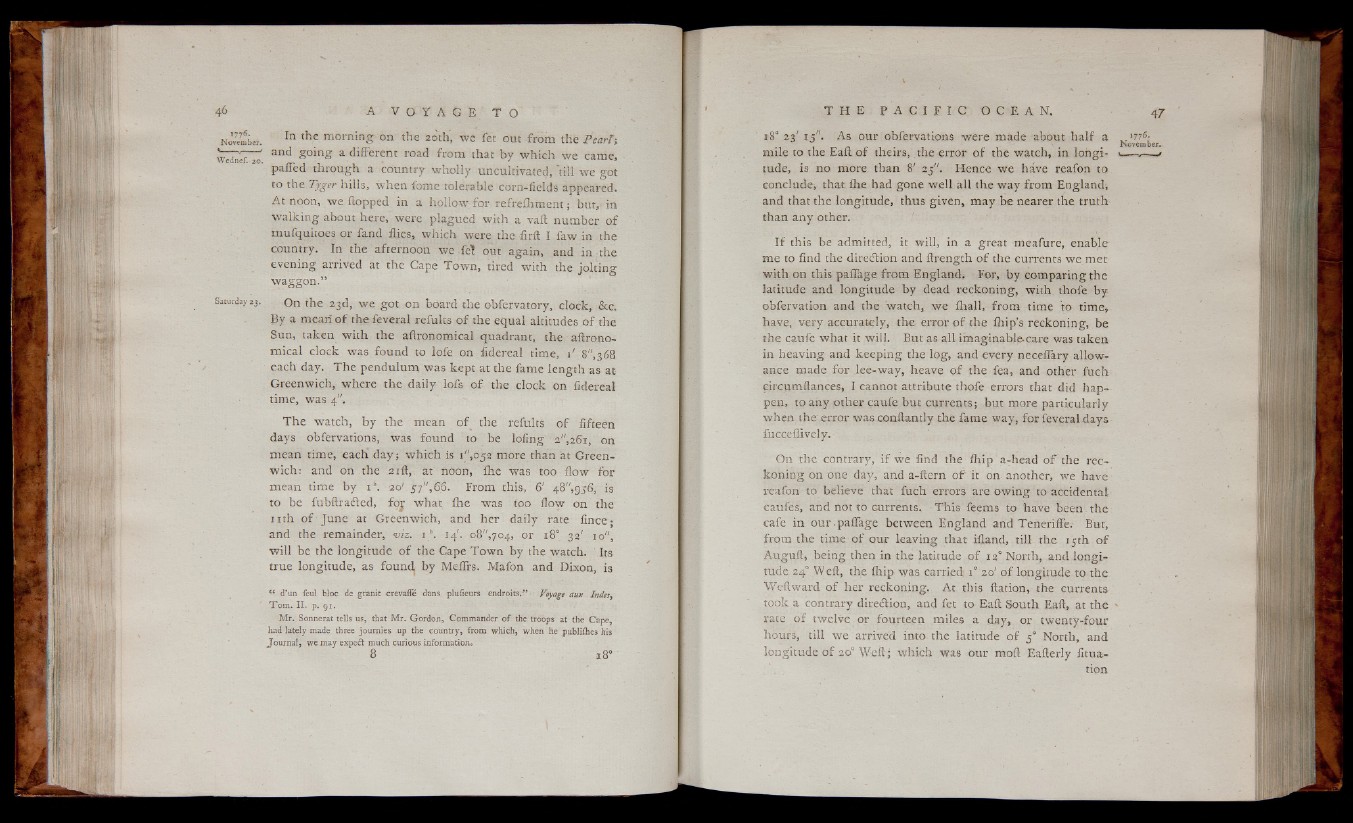
" * , In the morning on the 20th, we i f f out from the Pearh
Wcdnef." 10. go‘ng a different road that by which we came,
pafled through a country wholly uncultivated, 'till we got
to the Tyger hills, when fame tolerable corn-fields appeared.
At noon, we flopped in a hollow for refrefhmept; but, in
walking about here, were plagued with a vaft number of
mufquitoes or fand flies, which were the firft I faw in the
country. In the afternoon we fel out again, and in the
evening arrived at the Cape Town, tired with the jolting
waggon.”
Saturday23. on the 23d, we got on board the obfervatory, clock, &c.
By a mean of the feveral refults o f the equal altitudes of the
Sun, taken with the aftronomical quadrant, the aftrono-
mical clock was found to lofe on lidereal time, 1' 8",368
each day. The pendulum was kept at the fame length as at
Greenwich, where the daily lofs of the clock on fidereal
time, was 4".
The watch, by the mean of the refults of fifteen
days obfervations, was found to be lofing 2",261, on
mean time, each day; which is more than at Greenwich:
and on the 21ft, at'noon, Ihe was too flow for
mean time by r\ 20' 57",66. From this, 6' 48",936, is
to be fubftrafted, for what Ihe was too flow on the
n th of June at Greenwich, and her daily rate fince •
and the remainder, viz. 1 , 14'. 08",704, or 18° 32' 10",
will be the longitude of the Cape Town by the w;atch. Its
true longitude, as found, by MelFrs. Mafon and Dixon, is
“ d’un feul bloc de granit crevaffe dans plufieurs 'cndroits-.” : Voyage aux Indes,
Tom. II, .p. 01.
Mr. Sonnerat tells us, that Mr. Gordon, Commander of- the troops at the Cape,
had lately made three journies up the country, from which, when he publifhes his
Journal, we may expeft much curious information,
8 18°
18° 23' 15". As our obfervations were made about half a .. WM
1 n r 1 • 1 N November, mile to the Eau or theirs, the error of the watch, in lohgi- *— — »
tude, is no more than 8' 25". Hence we have reafon to
conclude; that ihe had gone well all the way from England,
and that the longitude, thus given, may be nearer the truth
than any other.
If this be admitted, it will, in a great meafure, enable
me to find the diredtion and ftrength of the currents we met
with on this paflage from England, For, by comparing the
latitude and longitude by dead reckoning, with thofe by
obfervation and the ‘watch, we ihall, from time to time,
have, very accurately, the error of the fhip’s reckoning, be
the caufe what it will. But as all imaginable-care was taken
in heaving and keeping the log, and every necefiary allowance
made for lee-way, heave of the fea, and other fuch
circumftances, I cannot attribute thofe errors that did happen,
to any other caufe but currents ; but more particularly
when the error was conftantly the fame way, for feveral days
fucceflively.i
On the contrary, i f we find the fliip a-head o f the reckoning
on one day, and a-flern o f it on another, we have
reafon to believe that fuch errors are owing to accidental
caufes, and not to currents. This feems to have been the:
cafe in our.paflage between England and Teneriffe. But,
from the time of our leaving that ifland, till the 15 th of
Auguft, being then in the latitude of 12° North, and longitude
24“ Weft, the fliip was carried 1° 20' of longitude to the
Weftward of her reckoning. At this ftation, the currents
took a contrary diredtion, and fet to Eaft South Eaft, at the |
rate of twelve or fourteen miles a day, or twenty-four
hours, till we arrived into the latitude of 50 North, and
longitude of 20° Weft; which was our rnoft Eafterly fituation